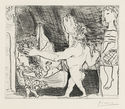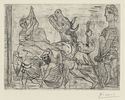
19th, 20th & 21st Century Fine Prints
707-546-7352 · fax 707-546-7924 · web: www.annexgalleries.com · email: artannex@aol.com
Pablo Picasso Biography
Pablo Picasso
Spanish
1881–1973
Biography
Pablo Picasso, painter, sculptor, printmaker, and ceramist, was born in coastal Malaga, southern Spain, on October 25, 1881. His father, Don Ruiz y Piasco, and mother Maria Picasso Lopez were of middle-class stature, both from with minor aristocratic ancestry. Don Jose Ruiz y Blasco was an artist and art professor who taught Picasso drawing and painting from an early age. His mother, Maria Picasso Lopez, recognized her son's talent and encouraged his pursuit of a career in fine art, remaining a steadfast supporter of her son throughout her life. Picasso first studied under his father, and then, following the family's move to A Coruna in 1891, studied at La Llotja Art Institute between 1896 and 1897- incidentally, where his father taught.
After the death of his younger sister from diptheria in 1895, the family moved to Barcelona. Picasso's father, now a professor at the Barcelona School of Fine Art, managed to convince the school officials to let his 13-year-old son take the entrance exams, which he completed in less than half the time of the other hopefuls and to critical acclaim from the professors. Within the year his work was being compared to Spanish old masters, but his academic career suffered. Picasso proved to be a poor student, uninterested in anything but his pursuit of art. In an effort to improve his chances at a well-rounded education, Picasso's father and uncle sent him to the Royal Academy of San Fernando in Madrid in 1897 at the age of 16. As before, however, Picasso spent his time studying the artworks at the city's many museums, finding inspiration in the boundary-pushing works of Renoir and Cezanne. He began experimenting with different techniques and mediums, including printmaking, creating his first etching in 1899.
Picasso visited Paris for the first time in 1900. There, he met French writer Max Jacob who would become his close friend. In 1901 he moved to Paris and roomed with Jacob in a small studio; both nearly destitute, they alternated sleeping and working schedules so that each had room to use the space undisturbed. It was during these very early years in Paris that Picasso developed his Blue and Rose Periods, and in 1904 he began experiementing with printmaking once more, creating a suite of 15 intaglios he titled the Saltimbanque Suite, which included the famed image "Le repas frugal." These went largely unnoticed for several years until his art dealer, Ambroise Vollard, took notice of them and published them in an edition of 250. Vollard would reconnect with Picasso again nearly two decades later to create Picasso's most famous collection of printed works, La Suite Vollard.
Picasso soon became attached to the circle of intellectuals, artists, and writers led by Gertrude Stein, who frequently bought Picasso's paintings. This brought Picasso in contact with several key people in the art world, including Henri Matisse, whose work made a deep impression on the young painter, and in 1907 he was invited, along with Georges Braque, to join the gallery of German art collector Daniel-Henry Kahnweiler - a fortuitous invitation that helped Picasso and Braque establish one of art history's most famed art genres: Cubism.
For the duration of the 1910s Picasso focused on the development of a style that showcased instinct rather than figuration, breaking away from those genres that were fully objective. Elements of African masks and fetishes, seen at a museum in 1907, became fertile ground for inspiration, and despite almost violent pushback by artist friends and art critics, Picasso was undeterred, developing new styles based on his theories of instinctual expression. Among his Cubist subgenres was "analytic cubism" and "synthetic cubism", both investigations of art executed through forms of deconstruction.
Exempted from conscription into the First World War due to his Spanish citizenship, he continued to work in Avignon and traveled for the first time to Italy, where he found inspiration in the figurative antiquities of Rome and Greece. This would inspire his work during the "return to order" period of post-World War I Europe, which rejected the edgy, challenging avant-garde of pre-War times in favor of identifiable, if still stylized, subject matter. In the early 1920s Picasso's work largely departed from the fractal Cubism he had brought to the art world; in its place, he produced figurative compositions in formal or neoclassical poses. At this time he was also somewhat influenced by Surrealism, but was never fully engaged. Instead, it would emerge in the strange and compelling atmospheres of his harlequin imagery, a staple of his early output, as well as elegant, sculptural nudes. By the late 1920s he reintroduced elements of Cubism to his work.
In 1931 Picasso's interest in intaglio printmaking was revived after an invitation by publisher Ambroise Vollard, his one-time art dealer, to create a suite of 100 etchings. This would prove to be a boon of experience for Picasso, working at first alone and then in 1934 with master printmaker Roger Lacourière who introduced him to new techniqes such as sugar-lift. This led to the creation of a series of mythological images whose complexity grew over the course of seven years as he perfected each technique. Done in a neoclassical style and meditating on themes of love, war, old age and youth, it would become Picasso's most celebrated suite. He finished the plates in 1937 and handed them over for printing to Lacourière; Vollard, unfortunately, would not live to see their publication, dying in a car wreck in 1939. With the onset of World War II Picasso was unable to obtain plates and other materials, and his printmaking pursuit was put on hold until the end of the war. He would create over 1,400 etchings, lithographs, and blockprints throughout his career, working with leading experiemental printmaker Stanley William Hayter, Atelier Mourlot, Hidalgo Arnéra, and the Crommelnyck brothers.
Picasso's life and career had been relatively unaltered by the Great Depression; similarly, the rising tide of Nazi sympathy was largely absent from his daily concerns. It wasn't until the Spanish Civil War broke out in 1936 and the death of his mother in 1937 that he took on the weight of conflict and death. He produced at this time his most famous work, the large-scale "Guernica", commissioned by the Spanish government for the 1937 Paris World's Fair and subsequently sent on an international exhibition to raise funds for reguees after Spain fell to Franco. Picasso, devastated and angered by what had become of his homeland, never returned to Spain. Anti-war themes and themes of social and personal anxieties and grief surfaced again and again throughout the rest of his career.
During World War II, Picasso remained in Paris, harrassed by the occupying Gestapo forces for his "degenerate" art but never arrested. He continued to paint and to illegally produce cast bronze sculptures with the help of the French Resistence. With the liberation of Paris in 1944 his reputation had not dissipated, despite being unable to exhibit for the bulk of the war. Indeed, his international notoriety had grown not only because of his prolific and ever-fascinating output but also due to the drama of his personal life, including stormy marriages, affairs, and public, bitter break-ups; relationships that would be a dominant theme in his work throughout his career. He began to exhibit almost immediately after the war ended, and he would continue to live and work in Mougins, France, and to exhibit internationally, until his death on April 8, 1973.
Picasso is undoubtedly one of the most influential artists of the 20th century. According to Konstantin Bazarov, he has often been compared with Stravinsky as one of the great chameleons of his time, each reacting to the crisis of expression in modern art by constantly exploring, thus passing through a whole series of phases of creative activity.







